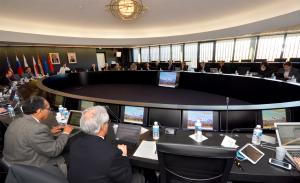They are building the physics basis for ITER
For the past 13 years, a group of some 350 physicists throughout the world has been working to integrate knowledge and data for the ITER Project.
The International Tokamak Physics Activity (ITPA) was established in 2001 under the auspices of the International Atomic Energy Agency. In 2008, the seven ITPA "Topical Groups" and their Coordinating Committee passed under the umbrella of ITER.
Last week at ITER, the ITPA Coordinating Committee met for the 16th time to review and discuss the experiments performed in 2013 in support of ITER and to examine the proposals for the following year.
Newsline seized the opportunity to sit with Yutaka Kamada who has chaired the ITPA Coordinating Committee since December 2010. (Dr Abhijit Sen of the Institute for Plasma Research, India will take over as Chair of the Coordinating Committee on 1 January 2014.)
How do you choose your research priorities?



